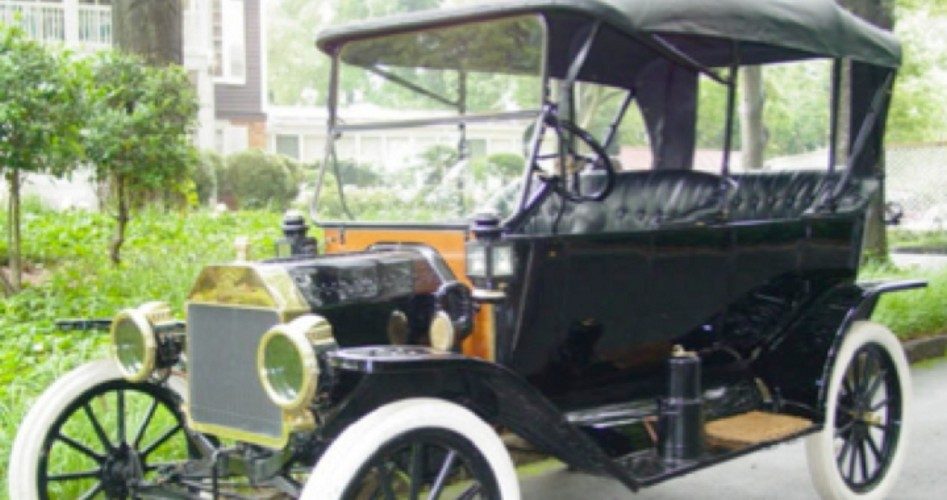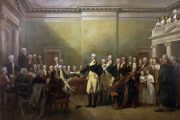
In the process of providing the world with improved transportation, Henry Ford accelerated the automotive industry, was a factor in the United States’ industrial growth and provided us a “freedom machine.”
In the mid 1800s, the steam railroad train was a huge leap forward from the stagecoach. Passenger trains initially lacked food service. When the train would stop at a station for fuel and water, the passengers would usually have to deal with rather primitive nearby restaurants. In 1876 Fred Harvey, a well established restaurateur, contracted with the Atchison, Topeka and Santa Fe to provide excellent and prompt food service in train stations. Eventually he had over eighty such restaurants, some with associated hotels. When passenger trains became more refined, he also provided 60 dining cars.
In the late 1800s, the electric street car arrived for intercity transportation. This was a leap forward from the horse and buggy. Portland, Oregon, had a street car system serving the city in many directions with a central transfer point in downtown Portland. Ultimately the passenger steam train was significantly affected by the automobile. The effect of the automobile on the street car in Portland was fatal. The impact of the automobile came about after an elaborate process of “trial and error.”
Henry Ford’s first attempt was the quadricycle in 1896. Next he adopted an alphabetical series starting with the Model A in 1903. There were short production runs for Models K, N, R, and S. All others up to Model T were limited to prototype status and essentially stepping stones to the Model T.
The breakthrough for Henry Ford’s car to serve the masses was when he heard about British vanadium steel. Since it has almost tripled the strength of common steel, he arranged to have the vanadium steel poured at the United Steel Company’s plant in Canton Ohio. The new steel resulted in a better, lighter, and less costly car. In the four-year process of developing the Model T, vanadium was designed into the transmission, axles and other heavily loaded components. The lightweight car and the delicate-appearing undercarriage were nevertheless very durable. The Model T acquired nicknames such as “Tin Lizzie” and “Fliver.”
The Model T’s debut was in 1908 with a price of $825. The competitors’ prices were in the $2,000 – $3,000 range. Over the next 17 years, the price for the basic Model T was reduced to $260, in 1925.
The goal of making an automobile that was affordable for practically any employed person was met. To make it affordable for Ford employees, in 1914 he introduced the five-dollar minimum payment for an eight hour day. Competitors were paying an average of $2.34 for a nine-hour day!
These achievements were made possible by Ford’s assembly line. He did not invent it, but did perfect it.
By 1913, the chassis assembly time was reduced from 12 hours and eight minutes to one hour and 33 minutes.
For 1914, Ford promised a $50 rebate if total sales topped 300,000. The year’s total was 308,218 and, accordingly, $15,410,650 was mailed out to Ford buyers.
The Model T became the butt of jokes by comedians and competitors. Henry encouraged the practice. It is alleged he coined the statement — you can have any color as long as it is black. Actually some models were available in various colors.
In spite of, or possibly because of, the torrent of jokes about the Model T and its peculiar design, Ford did not purchase any advertising between 1917 and 1925. Its peculiarities were numerous. The fuel tank was under the driver’s seat and employed gravity flow to the updraft carburetor. Depending on the steepness of a hill and fuel level, it was sometimes necessary to climb the hill in reverse. The driver’s seat had to be removed to add fuel or measure the fuel level with a black wooden calibrated stick.
For many years the Model T came equipped with only the barest necessities. There was no speedometer, starter, temperature gauge, or bumpers. Instead of a gas pedal like the competitors’, the Model T came equipped with a gas lever to the right of and immediately below the steering wheel. There was no automatic spark advance. It was done manually with a lever, to the left below the steering wheel.
Competitors used the traditional stick-shift three speed transmission and a manually operated clutch. The Model T employed foot-operated pedals. The right pedal was the foot brake, the middle one was the reverse gear, and the left one allowed shifting from low to high gear or vice versa. The transmission in a sense was a dramatic advance on the order of today’s automatic transmissions. It used a planetary gear system with bands to produce the speed shifting and reverse.
The four-cylinder 20 horsepower engine would run on gasoline, kerosene, or ethanol. Many farmers produced ethanol to avoid buying gasoline. During the years the Model T was in production, wheeled farm tractors had limited availability. However, cogged rear wheels could be installed on the Model T for pulling farm implements. The Model T was widely used as a stationary power supply. A flat pulley would replace one rear wheel to drive a bucksaw, thresher, silo blower, conveyor for filling corn cribs or haylofts, bailers, water pumps, electrical generators, and countless other applications.
The process of manufacturing more than 15 million Model T’s called for expanding steel mills and rubber-tire factories, as well as improved paints, railroad expansion to deliver the cars, road construction, and of course the dealerships and auto service facilities.
Ultimately over 5,000 accessories for the Model T appeared. The Sears Roebuck catalog listed parts and accessories for decades after the Model A displaced the Model T in 1928. The 1928 model was significantly different than the Model T, so Ford in effect re-started the alphabet. The 1932 Ford was a Model B.
On December 18, 1999, the Ford Model T was named the “Car of the Century” by a panel of 133 automotive journalists and experts. They began with a list of 700 candidates in 1996.
In the process of providing the world with improved transportation, Henry Ford accelerated the automotive industry, was a factor in the United States’ industrial growth and provided us a “freedom machine.”
It may surprise some to hear there are people of influence who are working to get us out of our cars and back into street cars. An example is the Portland Mayor, Sam Adams. At the City Club on July 20, 2007, he stated: “With 300,000 more Portland residents — it will look like Portland circa 1920 — a time when the main means of motion were with your feet, street cars and bikes.”
The position Mayor Adams demonstrates is part of the United Nations Agenda 21 “Smart Growth” project. In retrospect, in the period the Model T was in production, there were 15 million purchased when the total U.S. population was about 100 million. Hopefully the current population will vote to keep the “freedom machine.” For good measure, let’s expose the evils of Agenda 21.
This article was reprinted with permission from the Roseburg Beacon News, Vol. 5, Issue 16, April 18, 2012.



